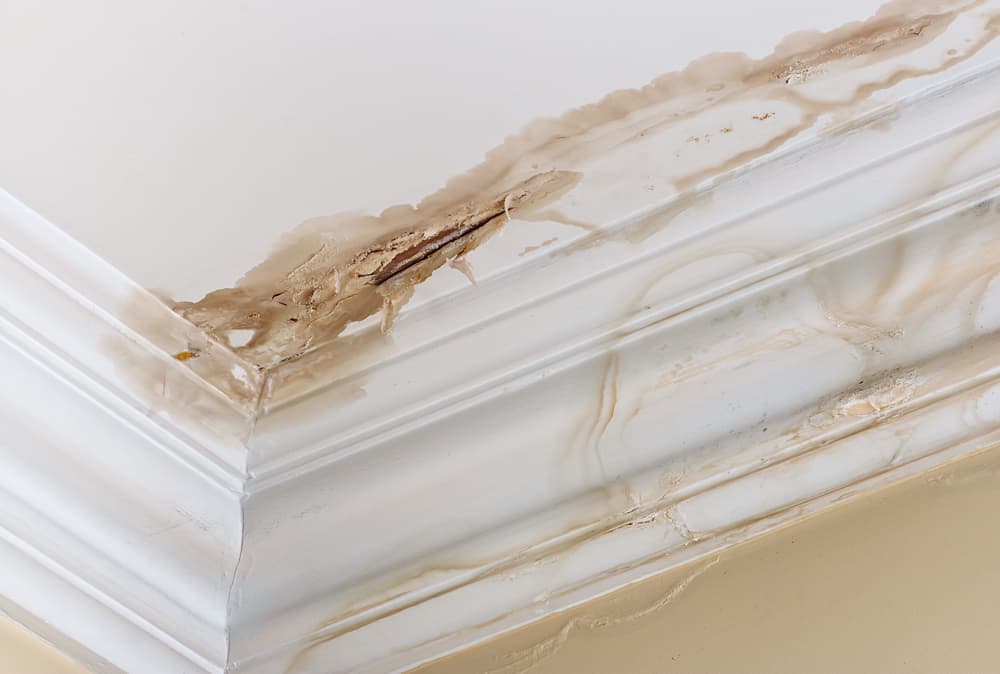Water damage to your ceiling can be unsightly, costly, and dangerous. The best thing you can do for your home, belongings, and health is to address the issue promptly. This guide provides an overview of what to do when your ceiling has water damage.
Signs Your Ceiling Has Water Damage
There are a few telltale signs of water damage; if you notice these, you probably have a leak.
- Cracked Plaster or Peeling Paint – When there is peeling paint or cracked plaster, you likely have a small leak that has left the ceiling wet for a long time. Plaster shrinks and expands when wet, which causes leaks. Paint will bubble and peel from extended water exposure.
- Yellow or Brown Water Spots – Although they may feel dry to the touch, these yellowish-brown spots mean you probably have a small leak that has time to dry. As the water exposure is inconsistent but repeated, the water will form rings and spread out over time.
- Water Leaks – This is an obvious sign and can be a significant problem. You may have a leaking pipe or damage to your shingles.
- Sagging Ceiling – A sagging ceiling is caused when the ceiling material is saturated and weakened by the water and the weight of the water.
What to Do When Your Ceiling Has Water Damage
If the ceiling has water damage, it’s best to contact Milliken Construction immediately. Our repair person will visit your house as soon as possible to assess the damage and plan the next steps. Here’s how our servicers take care of water damage:
Find the Leak
First, the service person will find the leak to prevent further damage. The quicker they see the water source and make the repair, the less potential there is for more damage to your home. There could be damage to your roof from hail, ice dams, a storm, or it could be wearing out from age. Clogged gutters could be causing issues near the roof line. Alternatively, lower-level ceilings may have water damage due to plumbing problems. If you are dealing with ceiling and plumbing issues, you may need a restoration specialist to help you identify and correct the problem. Our team will carefully inspect your house for all of these issues and help you make a plan for repairs.
Dry Out the Wet Ceiling
Next, the damaged ceiling materials and any insulation need to be removed, and the entire area must be dried out completely to limit damage and prevent mold growth. The most efficient way is with a sectoral drying dehumidifier and high-volume fans. The ceiling and wood joists need to be dry. Moisture meters should be used to ensure the area is completely dry. Your service person will ensure your home is adequately dried to prevent further damage or mold.
Make Repairs to the Water Damaged Ceiling
Finally, our team may only need to remove debris, clean the area, and then make repairs with drywall mud or plaster. Major damage, however, will likely involve cutting entire ceiling sections. The process differs depending on whether the area has drywall or plaster. Once the repairs have been made, our service people will seal and paint the ceiling.
Call Milliken Construction & Water Restoration to repair your home today.
Whom Should You Call for Ceiling Water Damage?
Hiring a restoration company is the smart choice to safely repair leaks and your water-damaged ceiling. Milliken Construction & Water Restoration has served El Paso and Southern New Mexico for over sixty years. Our certified and insured technicians have the knowledge and experience to identify the problem quickly. Our excellent relationships with insurance companies mean we can get the process authorized and started promptly. Milliken Construction & Water Restoration has a 24/7 emergency response and 100% satisfaction guarantee, so contact us if you have questions about water damage to your ceiling.
Image Source; Stocksolutions / Shutterstock


